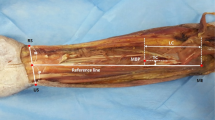Abstract
Purpose
This study was designed to clarify the anatomy of the intramuscular communicating branch (ICb) between the median and ulnar nerves in the flexor digitorum profundus (FDP), and morphologically demonstrate the location of connection.
Methods
Twenty Korean cadavers were dissected and a further 8 were subjected to modified Sihler’s staining to investigate the pattern of innervation of the ICb and the location of its communicating points in muscle.
Results
The median and ulnar nerves divided into small branches before entering FDP muscle. Of these small branches, one or two met inside the muscle. This communicating pattern could be classified into three types: type I, communicating branches in both the proximal and distal regions; type II, at least one communicating branch in the proximal region; type III, at least one communicating branch in the distal region. Of 20 dissected specimens, no case of type I was observed, but 3 cases of type II and 15 cases of type III were found. No ICbs at all were found in two of the dissected specimens. In eight stained specimens, one was classified as type I, two as type II, and five as type III. The proximal communicating branches were located at 34.1% from the interepicondylar line, inside the third muscle bundle. The distal communicating branches were located at 66.0% from the interepicondylar line, between third and fourth muscle bundles.
Conclusions
These findings could provide critical anatomical information regarding the nerve distribution of FDP focused on the ICbs.



Similar content being viewed by others
References
Bhadra N, Keith MW, Peckham PH (1999) Variations in innervations of the flexor digitorum profundus muscle. J Hand Surg Am 24:700–703
Crutchfield CA, Gutmann L (1980) Hereditary aspects of median–ulnar nerve communications. J Neurol Neurosurg Psychiatry 43:53–55
Gruber W (1870) Über die Verbindung des Nervus medianus mit dem Nervus ulnaris am Unterarm des Menschen und der Sfiugetiere. Arch Anat Physiol 37:501–522
Lee KS, Oh CS, Chung IH, Sunwoo IN (2005) An anatomic study of the Martin–Gruber anastomosis: electrodiagnostic implications. Muscle Nerve 31:95–97
Liem RS, Douwe van Willigen J (1988) In toto staining and preservation of peripheral nervous tissue. Stain Technol 63:113–120
Lim AY, Pereira BP, Kumar VP, De CC, Taki CC, Baudet J, Merle M (2004) Intramuscular innervation of upper-limb skeletal muscles. Muscle Nerve 29:523–530
Martin R (1763) Tal om Nervus allmamna Egenskaperi Mannisikans kropp. Lars Salvius, Stockholm (cited from Mannerfelt)
Nakashima T (1993) An anatomic study on the Martin–Gruber anastomosis. Surg Radiol Anat 15:193–195
Oh CS, Won HS, Lee KS, Chung IH (2009) Origin of the radial nerve branch innervating the brachialis muscle. Clin Anat 22:495–499
Oh CS, Won HS, Lee KS, Chung IH, Kim SM (2009) Anatomic variation of the innervations of the flexor digitorum profundus muscle and its clinical implications. Muscle Nerve 39:498–502
Russell T (1994) Essentials of human anatomy, 9th edn. Oxford University Press, New York, p 142
Rodriguez-Niedenfuhr M, Vazquez T, Parkin I, Logan B, Sanudo JR (2002) Martin–Gruber anastomosis revisited. Clin Anat 15:129–134
Sarikcioglu L, Demirel BM (2006) Martin–Gruber and Marinacci communications—anatomic or physiologic consideration. J Hist Neurosci 15:99–101
Segal RL, Catlin PA, Krauss EW, Merick KA, Robilotto JB (2002) Anatomical partitioning of three human forearm muscles. Cells Tissues Organs 170:183–197
Shu HS, Chantelot C, Oberlin C, Alnot JY, Shao H (1999) Martin–Gruber communicating branch: anatomical and histological study. Surg Radiol Anat 21:115–118
Standring S (2005) Gray’s anatomy, 39th edn. Chuchill Livingstone, New York, p 877
Standring S (2005) Gray’s anatomy, 39th edn. Churchill Livingstone, New York, p 1467
Sunderland S (1972) Nerves and nerve injuries. Churchill Livingstone, New York, Edinburgh, p 74
Acknowledgement
This research was supported by Basic Science Research Program through the National Research Foundation of Korea (NRF) funded by the Ministry of Education, Science and Technology (R13-2003-013-03001-0).
Author information
Authors and Affiliations
Corresponding author
Rights and permissions
About this article
Cite this article
Won, SY., Choi, DY., Lee, JG. et al. Intramuscular communicating branches in the flexor digitorum profundus: dissection and Sihler’s staining. Surg Radiol Anat 32, 285–289 (2010). https://doi.org/10.1007/s00276-010-0634-4
Received:
Accepted:
Published:
Issue Date:
DOI: https://doi.org/10.1007/s00276-010-0634-4




